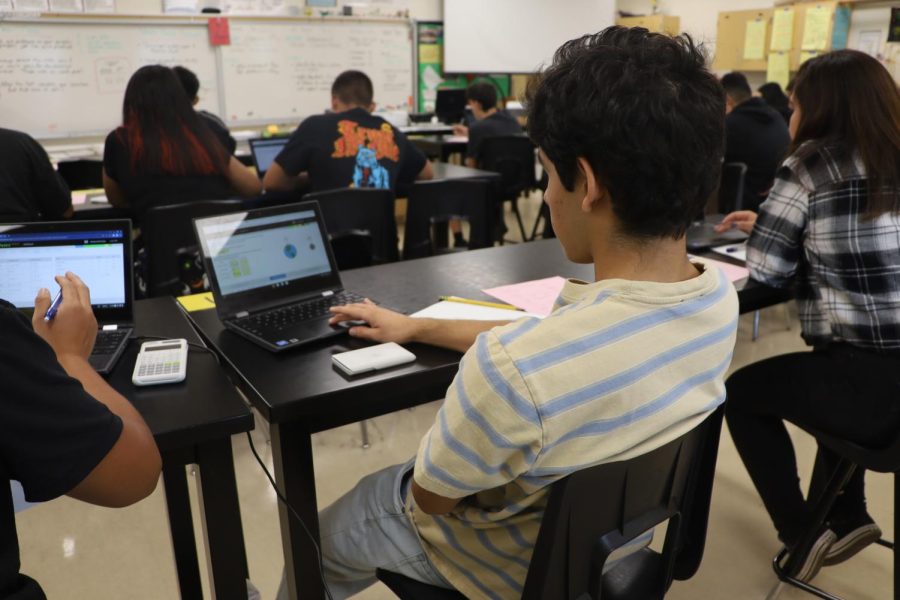Students don’t receive much empathy for mental disorders
Students fighting to pay attention in their class.
October 18, 2022
ADHD or Attention Deficit Hyperactivity Disorder is one of the most common neurological disorders of childhood. It is usually first diagnosed in childhood and often lasts into adulthood. Children with ADHD may have trouble paying attention, controlling impulsive behaviors, or being overly active.
According to data from 2016-2019 from the CDC, about 265,000 children ages 3-5 years old are diagnosed with ADHD, 2.4 million ages 6-11 and 3.3 million ages 12-17. Out of those percentages, 13% are boys who are to be diagnosed, and 6% being girls.
The information given shows that there is a majority of students, ages 3-17, that have to deal with a mental disorder that prevents them from learning, paying attention, being able to control impulsive behaviors and causing them to be overly active, and this can ultimately cause a challenge for their education.
People are bound to react differently to someone who has ADHD. They may be a bit more “jumpy” or tend to fidget with things such as their hands, legs or any item they have in their hand. As well, many students with ADHD have trouble listening and paying attention, get distracted easily, and seem absent-minded.
Many students can receive help in several ways if they have ADHD such as a 504 Plan, Individualized Education Program (IEP) and Behavior Intervention Plans (BIPS). This allows them to receive help for succeeding in classes. Such benefits are preferential seating, extended time on assignments, reduced homework or classwork, technology aids, audio-video materials, behavior management support, adjusted class schedules or grading, and verbal testing. As well, medication is an alternative that is more beneficial in attempting to help improve attention by helping normal brain chemicals work better. The medicines target two brain chemicals, dopamine and nor-epinephrine. These chemicals affect a person’s attention and concentration.
Although some teachers are understanding of the challenge that ADHD causes to students, many teachers tend to hang on the belief that ADHD doesn’t affect students and their learning, but rather it’s the student not wanting to “get out of their comfort zone” or making excuses to “avoid responsibility.” This negative outlook certain teachers and staff give to students with ADHD can create issues for the student. In some cases, these teachers or staff minimize or ignore the situation of the student, putting them in some high expectation situations can create a sense of stress and anxiety, which can ultimately lead to a state of depression, causing the student to minimize their ability to excel in school overall.
Ernesto Castro, a Sophomore at Chino High School, states “Personally, ADHD is more brushed off in the education system. Teachers kind of think of it more as an excuse for students not doing their work, but in reality, it’s an attention disorder, which is very serious… I feel it’s kind of important for people to know and learn more about these attention disorders. It’s not only ADHD, there’s ADD and a bunch more, and I feel it kind of takes away from children, teenagers and adults even at some point, the ability to reach their full potential as people, because of just this one disorder that they were born with, and they have to take medication for it. More teachers and people in general should be brought to awareness and informed about ADHD, because there is a reason a kid is failing in a class and it can’t be blamed on their cognitive capacity or thinking skills.”.












Anonymous • Oct 18, 2022 at 4:49 PM
Greatly written and articulated. It definitely shreds light on a topic that is not spoken enough on. Teachers and staff should definitely be informed on the problems students with ADHD face rather than setting expectations or blaming it on the student.
Yachi Guerra • Oct 18, 2022 at 4:31 PM
This is an amazing article! I know teachers are trained in many things when it comes to education but more training should be given when it comes to special education and what’s needed to those students! Students and parents also need to be aware of what rights they have in the education system when it comes to ADHD and ADD. The saying “it takes a village” comes to mind to make a child succeed. We all need to be advocates these students! Great job Sebastian on writing this article! You are giving a voice to all the students that struggle with mental illness.
Monica Cockrell • Oct 18, 2022 at 12:41 PM
Very well said! As a mother of a son with ADHD, I agree with the author on the misconception in regard to learning disabilities and in the lack of knowledge and training of those involved in children’s education. Thank you Sebastian for being a voice for those children that struggle daily with learning disabilities.
Valeria • Oct 18, 2022 at 12:04 PM
Very well written! Thank you for shedding light on mental disorders/ illnesses and how they affect students. Teachers and staff members should be more understanding to those who have these disorders and listen to them when they ask for help. They should strive to see every student succeed.